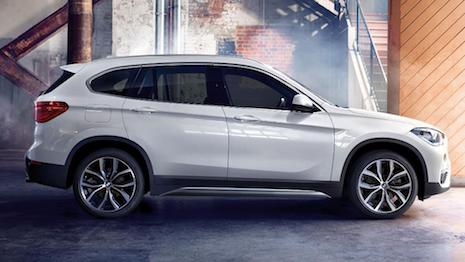Sales of sport utility vehicles have dominated the luxury car market in 2018, but the gap between high-end and mass-market SUVs is narrowing.
More than 1 million luxury vehicles have sold this year, 62 percent of which were SUVs, according to a new report from Edmunds. Growing availability of high-end SUVs has driven this trend, but the price gap between luxury and mainstream vehicles has also shrunk 10 percent in the last decade.
"As mainstream buyers increasingly opt for pricier SUVs and trucks and the luxury segment continues to roll out smaller offerings with a lower price floor, the gap between average luxury and mainstream pricing has narrowed significantly," said Jeremy Acevedo, manager of industry analysis at Edmunds, Santa Monica, CA.
Car sales
The 1.3 million premium vehicles sold this year through the end of August represent 11.4 percent of overall auto sales. More than six in 10 of the luxury cars sold were SUVs.
This year, high-end cars have sold for an average $54,627 compared to an average price tag of $33,346 for a mass-market vehicle, a 48 percent difference. However, 10 years ago the difference between the two tiers was 58 percent when a new luxury car cost an average of $46,416 and an mainstream vehicle cost $25,608 on average.

The BMW X1 is a popular premium compact SUV. Image credit: BMW
Traditionally, luxury automakers have differentiated themselves from mass market brands with better performance and styling. With SUVs, however, handling and horsepower are of lesser importance, which lowers the premium added to the high-end options.
"As mainstream buyers increasingly opt for pricier SUVs and trucks and the luxury segment continues to roll out smaller offerings with a lower price floor, the gap between average luxury and mainstream pricing has narrowed significantly," Mr. Acevedo said.
While most drivers who exclusively shopped for high-end vehicles preferred Porsche, Jaguar, Audi and BMW, mainstream drivers were also attracted to Lincoln, Volvo and Acura. Automakers Lincoln and Volvo also kept buyers loyal to their brands, while Porsche and Land Rover had higher rates of luxury drivers with a large share later trading in for different luxury vehicles.
Driving forward
While the luxury vehicle market is not expected to stall out next year, automakers will be facing new obstacles.
According to Edmunds, only 29 percent of high-end cars sold in the U.S. are produced stateside compared to about half of all vehicles sold domestically. While brands including Mercedes and BMW are bracing themselves for future tariffs by ramping up their U.S. production, the industry as a whole could face serious consequences if tariffs are enacted.
The tariffs President Donald Trump proposed could reach up to 25 percent, placing a significant toll on foreign exporters and the customers in the U.S. who desire foreign cars.
While likely aimed at protecting American interests from cheaper cars manufactured in Asia, tariffs on imported cars would also have an effect on luxury vehicles, many of which are manufactured in Europe. Many American-made vehicles include foreign parts, so tariffs would still cause production costs to rise stateside (see story).
Automakers also need to prepare for the impact that possible tariffs may have on sales in the U.S., as a recent study found prospective buyers could consider opting for used cars.
According to a survey from Autolist, 65 percent of consumers expect car prices to climb if auto tariffs come to fruition. Forty-one percent of car shoppers would choose to purchase a pre-owned vehicle if tariffs increased car costs.
Based on reports, if automakers choose to pass on increased costs to consumers, prices could rise by up to 20 percent — a difference of thousands of dollars (see story).
Until tariffs become a reality, however, automakers are expected to see positive returns.
"Luxury SUV sales will continue to climb and power the segment's growth," Mr. Acevedo said. "In the tail end of 2018 we expect several all-new and redesigned SUVs to hit the market as luxury automakers aim to fill holes in their SUV lineups to take advantage of unprecedented market demand."
{"ct":"tHnPsLu08f1lEB3uRhY2\/pT0th6juUTpexHHOoNpm19r2TLLqj0Qy+8xOFBhW9X5estbYYtKWwL1FBTkM8BC90TifZCwstXhItKS7BX0mi3snijrN0TB811zZ8jxAJFK9YtQMYfCSdTKcDL6I3twtaUFGr+FlZPdqYazxPcX5yOZGEeEOxfPHe9uKvc7BYNh\/QwvuHs1GVmmmI3a4p7V5IM8VQgCfLetfBSHDlG7jt+q9zCcFDKSXVbNbxHz5tZvE4el\/dAyONuU4mlLtSiHgMbeYD01i86+zHpUO9PywOF7Z8dd90igu5s+2Sn7x2cZEyvAemgK1Un7bQwU4oge44lp5FbThykHAq5+ToLN\/optkYEy9REfStrknZtRKaADU8gtfsBMjnFNqm38t5NUJF8+ggwVaVZjrn85ZpX9L0X48ZFuT8aEZDjsCaZ3ZL7C5eaIcB\/LZVKCI11XbCCIo+dzUky7ij1qFm\/pRTRQ6rHS9QYNWxfHsji1zUoxVDycJAPz9MdUus117T\/UmQqcdAYkxE5iZx3gz4WlP7+yY0L6B8xaZyNF2nFwR\/OfF4q8nTgOE2ZO543Yr+xaKOZLXy4SJnGwe56nd3yuRE8FU8vkCn4J+79L1phsxQmE2gwlozHleg\/wEwPyCXqzAnRgqKLFp\/y\/oEnV6doEQTavFBUegU2UqhvwcpPmCwDw6Q8o8ObMdaRFqJ5LLmr5hp3hlqiKvS2T3nNyjQwT2iFs98H6ZfPDzNUv3TvSOJ+vXBFdjxA1iXYHLlj5QJ2JBzhx4pFntOXzfV\/Y8SlyWUJX1EgL6Fhc5Z9TsQLGqCnImZfw2dbFjfORG8vfi+qAKTrvCwnDWo2Be9HJfrtUdHC22h4tHWoeRrzlJft5SPDOpU730tCnC22ubZcRQdw9colnYxGzG8BkVcw+eXPL5IO1HqRQ6u1Kk1mv49n0U6m9wtCkKDfaKmiLoLSuKHXZ7p4KPT+SWuUp4XM22KmgLiRj+yfgk1R87dFbIx2CQDLIGNtqqjO3wabKFNlWGziWcBMpKRxXM+EYN7u2XruQ8EplH8oV1w4qJH6ryv5QoysUetgtVON85t+esr84ajpEgm3mlKoWD4iLWCo8kbRQfFV0KUTh3JkV3WzN4MotpuODRCDITCjeNi3qdRYPQnQinND82LwJIqb7l4YWth94lEArgsHeXnVkOPAIuSl\/gWb2BNTJDrJ2xzJIIMNwU1TJtlZopswWT9CSngOKLYbhBZplgCIHDg0UrqO56coGgIBCzBEaKnUJMLxVXef4jWlwqX6wsz8rdvwnSn1VrKeSGuzq9XG02qBSicyvfDAPPEPP5Pu5EZGriBMhzOVVXuwUuhZqPvNMQvJXqccKGsEw1\/ejxEPBpr2hGc6FlX9+N24NiTPE2+8JaxwOWtx82rddYfHvxlIoyh2b0Z1LdnyWyR6O7irgiLKrtvU8nxVdXC+qucS\/ZPwsZjiWsqkwd2UYJVgpHuvrNqOScXmvrIF1qH3bOPbdYEwMmWwW9kO6n1hgpBdaUcw5owznQd5xDM35BOczIuvPSuTu1AUYX5T40PyfVsTtyvdd7X7QvGiqZDadCSOQUlzDOvdoEMhAZOnEZbehlM7GQky+p9MNbiBYVMslHUeCIBhF2jPpZiEXp9ywKvgDzCeof81\/VivFXrLOGXlzmDmMWdkFz1cWoIQgZVhFZ4A\/zhaCtJCEW+55D7F1uPkFWX3uQTG4JIXlxtKMK0ordXjehUTcR3X7IGZoaBEDLOVmWYvDhPi414WhJppJZQSN6Yu1OrojVpistGqPviGLQ7H7tKt6jZYIYTDMOaNd0ObWG4BAeyZewssQFbdam4vlr\/0M0LcevPV3N+vx5MooEQqyhtkgL2GzV3uoB\/fPgqiyp+I8CJAYCFAqzqlbPkIvElEXAInjBcUVvfmHjIXzpWCRKPt4if3PF9LAXRAhVgnT4onNrvCxmEM3m2SMpEXIj0evgEcgFFGQXw9gT74zBvA5ZErPgPCjvDPTbfzKqcsFdgMEu6wV8W6TjBz6BbnFQ\/HPJGSdcBDoo09OdUzzQAYWaZcZX\/hTWPSkUPj6XfQ5bT0v+SG+DkoCy\/DJYcKda5RFUBOgLJ8kktDfrYki94SWienc8xLYwoOLVGbH9vKwKo\/o2xg7xuwadPcPJK75BWB0k9uak3q83ShStwbqVbzaZe6I3x+BJtBJV+iMX7wd85SJdratastejI6DjoTNNvkRdQQeiniwGIRTuJARmdB+uA5G54TxbR88pGs3EzQAd+\/TMA62YkzWkeCceh01laT4BNtwSKPQL0dE5BtZCrBDb7Zf\/Xx8YXz1naFOLdcAbyP5vwaTp2iUpAvLu\/QmRRVh0au5sK8BJWO2mSeS8I2vkXevkzXpRbCt50g+EGT8Hrcd5Jes+WWTyC9HKYUDEZaEygBTIgdUTdCPtRzK39PogaAT6PI4s13jXXGXneZpnBYZPE3xmWX9zWZLrPYrxW9ZgEJM2XUaa5tIFjjguPNLhvP4oCz1MYDuqLSlj1qE3bvYgmZRE4TU2KauVYaLidSNI8c56FReJkYgTo3AoqEFp1ipS4UYeG8JeDQAAkiaxmagISaxIZzDJw92Qis+\/p1k9jEAOLrF6jYjIHYWF5ez5XFboXi0ETkryg0JZFHj6DcNUSBRAMuvwL4KML\/GJVo\/a4bTlvVNTy5yE6y17CgJN1Pj00Rf8\/qEIg4w6ilaNCED8m+VIzFPSl4xblra0eAKfJq\/XXo5Li3uvkXZzFHahE1R8yqeJ9XIEa4RyBb8Z9PX0QGdP1EpmIUG5PZFzFd0pmML+pk7YTlYe54V4rm6PCC+qwlvkDxpZnFcyNGjVaM75ChXN8HYJsNgMpmFK5JcnccJED+LjlZhHFQ64sFkhq\/+b4JXnrRBqfAAdi3w9ha\/Jx1z4xpyN0TVuLN72FdsnfrPlMricu6VgA+kXaQb5vd6tpCWeVD+Nc1qdPvR+IvqY81i82yJB8pFC8lLpW8i4+mFVUzM+U\/0od0q7\/\/oyAC5Bd+lkt9LfVe9HaEFjR\/Jzn\/In\/cZ1zj2+tBZcTaqlutFfqO+kJJsPi\/EOwjgQyHdqgM0jlWStzRbe1fJ4nep2LflmXCYiNqbLLaTNTTOWKweyEhMSyReMzLvq\/6FFxOXoRpzXFaHcMctY+5ACfZrPbkHgE6CPjJRUl8mcEJiPGN0Ccr06hKg3Y41SBAjJtrjm0McSOmOA7X3lxJNGhCNPTOS4OL252dOh6i4F8sQZH82uygpxSgpzn2vzmQKbp+204YZOYe0xx\/FpcGZGDjgV7vpchtrFP1iaGWIDDSzU633MA9OBlPSfuqrPLpG6PGt7i5kciXnyB5sGZvXNUg7MjJdXKObSZ6s15AK330TVsuGaFMaKMZiFwJ9Nib+sD7KZnAhL\/C23Q3z0u2bK5aakJZj4jWt6kzuHidotj4j8SPkWZrQRlMVBeJmCqzinbo3hLBnMNmX4lEOJO+jH3JfsiuvPx4qlaEnCxfVkLXuvQhzYXshmDYZNVFiLKL8VGf9l1jYE6+jkje3ahuX5bCoD9omxZI9iZ1dCvMLdIrBA+LQZbBqTMmbcF4i7dRme0TaTyX4Yc71oRRqJx0x4NeSo61PXgt142g0eMPi1iSSMkrHT45AXh8PBBKE+Csk\/\/Qp+cdzrj8K8aFhcZCQoQC7nO3m0BueXN7OkFEhRVdzefH8Pq\/HvXRVjebYZEKZGoYjpkcgyyOS3oJmpnjUKuhc7Q2wtfeNTJqiho3N3TS6C2lAzpDAA2rcBE6H8bLHUBod1t1FV0xTJw7inIcpztM+W4pu4pfbOfqOzed3dZoMRzAr0QmFXW6oNL47pZQf+H2JVgUWIF2RltMqhFB24zaiw2\/THBNmQsLyUkbQNFrHITRinSR33oGSylvvOeuYLPHrPU0WXRIaLgjcV3AjwdOY5BC\/TaDmL7JkMqhI8Xsj5UTijcl7FhRAExstz1j4wxFxXAIcFLNFAQCWLYZF8mL5CdAm6cyNYqY\/uRm8ilsiK1FbuADJi6h4Km6SwNpaj3IHD+MphpQXZfF8xuL5YUddeuvjXJlqg6bJMqtWGXHWutreUTesFHcCA1XrC6VNLh6WWoQllVa98ocbrz8SFxYTSPfCZzQtqrmsLfsZI\/79CfdnUBussev5bamhX0y84BYQOT9u8mjYPfwBii\/q9FF1IXQp4KCpAM1qW\/dDKCUUDrzP49v3qSzAAacCpKtuTQkZXYdNYuleCI\/h8RC8f6rS2cWY2LWILIF\/i\/LlIO6qcPKTXWV4tXauUPwMot\/Cg2d\/DTbSHUqPtstskzs3E4hq+3kx+uBlfTriQMxpw9lq1pu6sk2W\/Z\/sf0yXkrlnjL0EVV+icMFBs58VcUnu2n53KeioL6IPeGhXuYWefxXkh6Y5sg1PEAAIeh2izPTIiMd0FjfFdN9IQ+a9TQgoeZzHK1r8sshZuS4REg9O4aJ9yW4JofdFDIMb2tEfMmYYNPIlrtp7gBkuEEjQV9bHV\/ap3hzMHNyH9u1WX5FWZviCBQWh222V3O36NfDub6WC2pR3aB\/LqXGWGtTg0MFUHyrIyTYDtCRLS62EezXDmlDuzpBoW1fvIrXbp60nju5r6O4wVkGVKdqTV3iH+zpVvpuHCHJlNwxBNGG\/8VakOa4LNDNUCN0kPpnTw0ntKDBvjGkzmjiylHL1rJjE8JGnSyPofIUWJYaGyzksRFsIHKi09aaFg5w0eYbrkp5F6UQ50DD\/dydyZCpUkUjnjqLTtIQK0ZarXgIXgMGWtAe8CZPEG\/VbqORu\/uGDpWULfXxDSnvzNnktHjk5TleLdI+fX34b37ZVccsnR+51+FHAC92qScXcNRrM17V45lTDUswyMGIbzKRLHNcHSyCo0oenjP7wUyCpc5KGwXuKnSdtfLAxjTjulzEfGx0UdJ3iGpWoW1mdo1sWu5nr1\/HHPlcHQITIo1rUxwa6UAd\/fsTvZleG1i\/i5IsbSP6bIHZg4xWK400p8Y\/m8SC7E2H1x9AcahF9gk9qRbjrYpPkekIIy3MzzkJpWNek\/bOYfkemZKA78jBsa307dx5pLjrP2zO0m4rNO8Ga09tIY3aql\/xuE8HprWHMF2Zqdn8Hm4FevwoenQaF3yjVFtyBmARmkooC0Rw4tfYsbsQC+qQESeUhDUOE4kfAggGxlsAPRHX0rrvdgp95Wyy5gxPiQ2VEw3gwf\/Oyt\/sGJRc5rmjklmZJlj8J+ZCAKWyhp310rrMkN5k68ymJ\/vNWenTEOeCrrr9ySJNUb2pTrJR+hMDGcbVhm\/EEY6kA9+vurGCsRfptFclzB52YHgE5B41tBVoTaLxC02s4sSBHJMMLUASAxnlncqk992\/ju6a9uSwKjFFDQ8vTdE9WkZ1NM6rrea9zMq+1lA2xUc2BiRFpGMmwQfqaxfwjiHUm9STstkck+pp02FfJQN\/VawX5y6OyUab+stC0Enavk49dOJGDAJT\/i1DOsSf7EhlbhkdPLzu2RwEnDX8hmH\/avFdCfzTU8uMNiz\/RqWvbZsv2SDxX6nVTzcJu72FuDW5Gmfgs8vqQ5t4xaQGPbqDIkQrNFQIjGniNlM9f6JKrvFHKO9srXtviy1kqkoFIuyMsamQUX0hT3E2isPdP5w7Tt8Xu9JaureP1oeBlL6b6gCvbKGEBTt6Dw8fLmaB7\/ejd+Y9pOhVaq7SbtH0hvd+C7rGboDFbxhZlcy+tRTc7ZLlV777lAaFiaIqN9qWAyTmQOVqzPGVve+W0lVE2169QhWdRN8lMNHmN8cE+fj7O5axUR\/0emAHPlehxlBI6Pr0CaSNwwaiNKgT3hhZLenD6trzvdAMm8\/Jbw6cGPm\/9NQ3ADNrGZk9GotztGcBnbnP9kxc5GQYs\/wSPEhOpvWuH0ngJrdnJxZTsr\/c8HcC\/BLaz5V\/zARjv63G8ZX0vZa984Xn2mvRDWpWeYh0Nb33x1fd9ajUFKZG6AYQX8SSCVXY8ppg5iZCO9v8AJnqcx115o37O8mqO854sLxDHlZV8YGqwJr13xAj5cOr6UBuv0N1pi3l48JilBo5V9Lw2xWyVP\/v5tpZl8tU3rdXorvc96ovgHgibwSk0ntZj7cJBEMQinhl5bjn8zobYjc6FqCKxtMuOE51edFbqztKyfBM9W7gXSO6CUzis\/1SbWPwGoF4cVL35srSy1+T\/CR38nlce1SQDvLF+KXjYX4o2h3EViWzXKwGIKTHoFmiyuoPfJvROkNQjqAiKwp9BRPWi64Sps\/0+7055ZSQxaqKVem9nWUK8LsTVvIaivgDpRA33PVkrzz\/gGeeVyJ1AaNEZ4GPNiUJebBRAbmQEiUsQep1gElMkKL4qs\/zJZqZsNYpypXUB11s57PoBSjp6IcF63K9y8nd1XzDjp3JUaa6g6d24FHfYq6ler+Id853z6sMJJmx9JTjTTM\/GoaDtiEy8TcSjV\/LFik7+zkrOMqeo7A\/biD2Rnl2D4W+ZMb6vt1LP\/R+qNm8v7xZvhycc8nULQThiAVPLlgHy1YOB6ABt4N\/EDBRIOF80mz7eFnzWsNsfkXuN2QB6TQjY6l5RS1pKb5n8quyW\/+qGc979t5BldQHAhFR2TMh8rSmyttGi0vx9nRyFXuGAq8Uo1qQogpJzooFL\/TZSGkB6LbVk7s0FaK6ncry3J1vpi\/zK8hLowDgIsMrHTjzEPP\/JyaCrSlGX6CfjKEOWrO74x9yVYut1kfyndF9kxaLbNNBn8KUlwZ1M4gtzEpCFH3QqAiUBbYMTgQ8sasGRWVg6EpsaJp9AMYvewpzbom6ac1S942L2m0iuRGdbFzRA6RTN3srp","iv":"b076d1a21d99c51e3b3ad8ffcf031a87","s":"e53399d59954ae50"}

 Land Rover looks into all-terrain driverless SUV. Image credit: Land Rover
Land Rover looks into all-terrain driverless SUV. Image credit: Land Rover